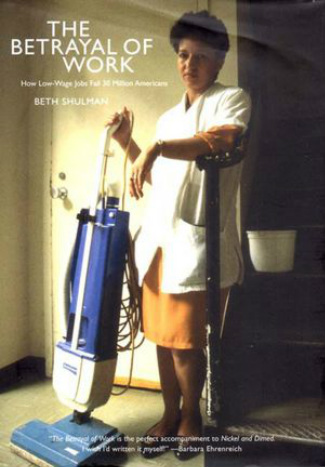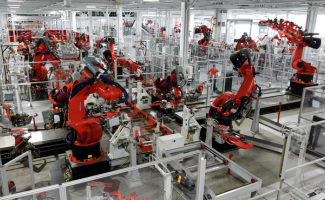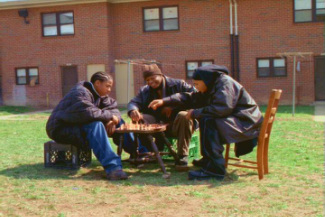 Lynn Marie Smith of AFT-Michigan at a protest rally Tags: capitalism, class, economic sociology, inequality, organizations/occupations/work, benefits, exploitation, jobs, part-time employment, profit, 00 to 05 mins Length: 1:54 Year: 2010 Access: YouTube Summary: Written and performed by Lynn Marie Smith of the labor union organization AFT Michigan, this catchy song (sung to the tune of Stevie Wonder's "Part-Time Lover") addresses the plight of the part-time worker. Everyone agrees we need more jobs, but is part-time employment the answer? Some people may just need extra money for a short time, or can only work part time due to other responsibilities; for these people, part-time work is a boon. However, for many other workers, part-time jobs are a trap. In fact, a growing employer practice is to require part-time workers to have around-the-clock availability. And if such workers cannot report for duty when called, or are even found to have another job, they may be terminated. One of the biggest financial problems with part-time employment is that such workers not only may make less, but also may not qualify for benefits. And with the new health care provisions that will be enacted under the Patient Protection and Affordable Care Act (i.e., "Obamacare"), there appear to be clear incentives for employers to increasingly transform jobs from full-time to part-time status. Indeed, a recent article by Furchtgott-Roth of the Manhattan Institute suggests that employers could theoretically reduce their cost-per-labor-hour by half should they go to an all part-time workforce in order to minimize mandate penalties. Yet, there is already evidence that shifting to part-time workers may generate backlash. For example, in anticipation of health care insurance changes that became effective January 1, 2013, Darden Restaurants, owner of Olive Garden and Red Lobster, announced in October that it would be moving even more of its 185,000 employees over to part-time status, despite the fact that about 70 percent were already part-time. However, citing adverse public reaction leading to lower sales in test market areas, Darden just announced that it was suspending such efforts for now. Another example is the coordinated strike for better wages and solidarity in New York of fast food workers in November 2012. This clip addressing the plight of the part-time worker can be used to initiate class discussion on how shifting work arrangements in the new service economy create precarious job situations for many American workers. Further, viewers can be encouraged to consider implications of these shifting arrangements for worker benefits and job satifaction. (Note: A version of this post originally appeared on SoUnequal.) Submitted By: Marta Gordon & Michael Miller
7 Comments
 Tags: capitalism, class, corporations, inequality, economic sociology, organizations/occupations/work, 21 to 60 mins Year: 2007 Length: 24:15 Access: PBS Summary: Although The American Dream says that hard work will lead to wealth and success, it doesn't seem to apply to most of Americans. Indeed, the smallest economic returns go to those generally laboring the hardest of all: the working poor. Billionaire Thomas Peterffy argues in his anti-Obama ad that America's rich will lose motivation to work if they are required to pay more taxes. But while preaching the value of hard work, he fails to note that the rich have virtually monopolized income gains in recent years. Reflecting on the unequal opportunity for financial security that the class structure presents, the late Beth Shulman, in her 2005 book, The Betrayal of Work, was one of the first to examine the diminishing well-being of the working poor. The above clip features Shulman's interview on PBS's NOW, and at about the 12:20 mark, she observes that while worker productivity has grown significantly, higher incomes have not trickled down to those in the bottom reaches of the American class structure. Indeed, she notes in this 2007 interview that "The top 1% is garnering 80% of income gains" (Note that today the top 1% is garnering over 90% of income gains, according to Emmanuel Saenz). With this being said, how is it possible for most American workers, and particularly the poor, to sustain their dream of a better life when their incomes remain so low and stagnant that they continue to struggle just to get by? (Originally posted on SoUnequal). Submitted By: Tara McQuay  Tags: economic sociology, inequality, methodology/statistics, organizations/occupations/work, prejudice/discrimination, race/ethnicity, affirmative action, field experiment, hiring, institutional discrimination, labor market, racism, stratification, 00 to 05 mins Length: 3:40 Year: 2010 Access: no free online access (but currently available on netflix); YouTube preview Summary: In this clip from Freakonomics (start 13:50; end 17:30), economist Sendhil Mullainathan discusses his (and co-author Marianne Bertrand's) 2004 field experiment that examined racial discrimination in the labor market (article here). They sent out 5,000 resumes to real job ads. Everything in the job ads were the same except that half of the names had traditionally African-American names (e.g. “Lakisha Washington” or “Jamal Jones”) and half had typical white names (e.g. “Emily Walsh” or “Greg Baker”). As they illustrate, people with African-American-sounding names have to send out 50% more resumes to get the same number of callbacks as people with white-sounding names. In the video, everyday people also discuss how others make assumptions about a person's race based on their name. This is important to understanding how racial stratification is reproduced through the labor market, and explains part of the racial gap in income. This study is further supported by Devah Pager's (2003) classic audit study, where she documented similar effects of racial discrimination through in-person applications. These studies also highlight the importance of affirmative action policies in attempting to level the playing field (although Bertrand and Mullainathan's study showed federal contractors did not favor applicants with African-American sounding names). The video can also be used in a methods class to illustrate field experiments. Note that this is the second post on The Sociological Cinema, which draws from the film Freakonomics. Submitted By: Paul Dean  A factory run by robots in Fremont, CA. Tags: capitalism, economic sociology, globalization, marx/marxism, organizations/occupations/work, science/technology, theory, assembly line, deskilling, jobs, labor, reskilling, robotics, 00 to 05 mins Length: 3:58 Year: 2012 Access: New York Times Summary: This NYT video examines innovations in robot technology used for factory production (see associated article). These robots are far more sophisticated than typical factory robots, and they have important implications for work, labor, and the geography of the global economy. As Marx predicted, global competition drives producers to mechanize their operations to drive down costs. For example, as the article notes, "In one example, a robotic manufacturing system initially cost $250,000 and replaced two machine operators, each earning $50,000 a year. Over the 15-year life of the system, the machines yielded $3.5 million in labor and productivity savings." The robots are replacing huge numbers of low and mid-skilled workers, making assembly lines more efficient and creating some higher skilled jobs. At 2:50, a representative from a robotics company states "We don't view robots as a way to eliminate the labor, it's just an opportunity to raise that skill set and help everybody realize a better life as a result of that, get them out of that repetition and into a place where they can earn a higher wage and be more successful." Viewers may reflect on this highly optimistic view. In some cases, these advanced technologies are bringing manufacturing jobs now held in countries like China back into the US. With the automation of much manual labor, the new jobs are often safer - but they also have new forms of stress and higher insecurity. However, many people who lose their jobs do not have access to the education and training needed to reskill themselves for the new jobs. Furthermore, such technologies might lead to the increasing polarization of jobs in terms of both skills and wages. Who wins and who loses when robots replace human labor? Image by Paul Sakuma/Associated Press Submitted By: Paul Dean  A scene from the 2012 Olympic Opening Ceremony. Tags: capitalism, class, durkheim, economic sociology, marx/marxism, organizations/occupations/work, theory, weber, alienation, disenchantment, mechanical and organic solidarity, species-being, 11 to 20 mins Year: 2012 Length: 20:00 Access: YouTube (start 13:40; end 33:40) Summary: The London 2012 Olympic Opening Ceremony focused in part on the Industrial Revolution which is seen to be pioneered by both the British and Europeans in the 19th Century. The ceremony opens with England depicted as a meadow, showing its agricultural past, then continues by depicting the industrial society that followed. This clip can be useful for illustrating many sociological concepts, such as Durkheim’s concepts of mechanical and organic solidarity; Weber’s concept of disenchantment; Marx’s concepts of a two class system, species-being, and alienation; and with the presence of the Suffragettes in the latter part, the clip can be used to introduce Feminist Perspectives. For example, Marx’s concept of species-being (the naturalness of human’s creativity and interaction with nature) is evident in the previous feudal/agricultural society, where the actors are seen enjoying nature and creative activities symbolic to the UK (such as cricket and Maypole dancing), interacting with family and friends, and partaking in ‘productive activity’ which they can relate to, e.g. farming and creative work. However, the people become alienated from their species-being through the era of industrialization. As capitalism developed, workers experienced alienation from their ‘productive activity’; alienation from the ‘product’; alienation from other workers; and alienation from their own creative ‘human potential’. This is shown in the video through the factory work occurring with greater numbers of workers, but with no contact among these workers with each other, working in unison like machines on products that they have no relation to and unable to express any form of human creativity. Viewers might also consider what is missing from the clip, such as colonialism, as well as the race and ethnicity of the actors (as compared to colonized subjects). Submitted By: Michelle MacDonagh  Tags: children/youth, gender, marketing/brands, organizations/occupations/work, science/technology, adulthood socialization, 00 to 05 mins Year: 2012 Length: 0:52 Access: YouTube Summary: This video was published by the European Commission for a campaign designed to attract more women to a career in science. The commission said that the video had to "speak their language to get their attention" and that it was intended to be "fun, catchy" and strike a chord with young people. The original video was taken down after it received so many negative comments. This tactic, however, of flashing a few pink gimmicks in an effort to get girls interested in (or purchase products related to) traditionally masculine activities is nothing new; instructors can point to numerous examples including the marketing of video games and computer technology (both the hardware and software). This clip would be useful for illustrating to students the ways in which gender socialization, often discussed in the classroom in the context of pink and blue toys for children, carries into adulthood in very obvious ways (e.g., Dell's short-lived Della computers). However, instructors might ask students to name some less obvious ways that gender socialization in adulthood takes place. Further, instructors might take a counterposition in an effort to spark classroom discussion, for example, posing the question: What's the harm of using a little pink and slick sexuality to get women involved in science? If successful, wouldn't this be a feminist victory in that more women would move into an occupational field currently dominated by men? Submitted By: Anonymous  D'Angelo teaches Bodie and Wallace how to play chess Tags: capitalism, class, economic sociology, marx/marxism, organizations/occupations/work, theory, class consciousness, gang hierarchy, gangs, labor theory of value, 00 to 05 mins Year: 2002 Length: 3:09; 1:34 Access: YouTube (clip 1; clip 2) Summary: [Trigger Warning: these clips use extensive profanity and racial slurs.] In the first of these 2 scenes from HBO's The Wire (season 1, episodes 1 and 3), D'Angelo teaches Bodie and Wallace how to play chess. He likens each chess piece to a member of the gang hierarchy, illustrating the stratification structure and his consciousness of it. For example, the king is at the top of the hierarchy and allowed to do what he wants, the queen moves where ever she wants and gets work done, while the pawns protect the king. Like the upper class within a rigid capitalist structure, there is also little mobility within the structure: "the king stay the king" even though he "doesn't do shit"; "everything stay who he is" ... unless "they are some smart ass pawns" and can climb the hierarchy. In the second scene, the characters discuss value and production within capitalism. While enjoying a fast food lunch, Wallace suggests that whoever invented Chicken McNugges must be extremely rich because of their popularity, but D'Angelo explains that the worker who invented chicken McNuggets "is just some sad ass sittin' in the basment of McDonalds thinkin' up some shit to make some money for the real players." This reflects Marx's labor theory of value, which explains how capitalism is structured to extract value from the workers (the true source of value) and funnel it into the hands of the owners (i.e. "Ronald McDonald" or more accurately, the stockholders). When Bodie responds "that ain't right", D'Angelo says "Fuck right. It ain't about right; it's about money" and explains that whoever invented the McNuggets is still "working in the basement for regular wage thinking of some shit to make the fries taste better." Both clips illustrate D'Angelo's consciousness of the class system, and its inherent injustice. Viewers may also be interested in the restaurant scene from The Wire that examines cultural capital. Submitted By: Paul Dean  Alex Castellanos and Rachel Maddow argue on Meet the Press Alex Castellanos and Rachel Maddow argue on Meet the Press Tags: economic sociology, gender, inequality, methodology/statistics, organizations/occupations/work, prejudice/discrimination, empiricism, feminism, gender wage gap, income inequality, 11 to 20 mins Year: 2012 Length: 14:42 Access: YouTube Summary: A few months ago, sociologist Phillip Cohen blogged about a feminist viral statistic meme, which claims that women own less than 1% of all the world's wealth. It turns out, a credible source for this figure can't be traced and is unlikely to exist. As Cohen's post reminds us, the very statistics that shape how we understand the world are sometimes little more than elaborately disguised rumors. So what about other influential statistics? What about that viral statistic which states that women earn about 77 cents for every dollar men earn? When people have denied gender inequality exists and when they have implied it is unnecessary to enact policies aimed at eradicating it, the 77-cent statistic has often come to the rescue and thwarted derailment, so whether the statistic is accurate is an important question. In the above clip, Republican Party strategist Alex Castellanos asserts the 77-cent statistic is untrue. Could it be just another viral statistic meme without a source? The short answer is no. The longer answer is that 77 cents is an average, and the number varies based on profession, age, and race. The 77-cent statistic can easily be traced to a respectable source--the Census Bureau (the U.S. Bureau of Labor calculates the number differently and arrives at about 81 cents on the male dollar). The point is society needs an accurate description of the world, lest our dominant understanding of the world become solely derived from eloquently stated assertions by elites with narrow interests. In part, this clip makes a good case for the potential importance of sociology, and in particular, a sociology that checks its sources. It is also important to have a sociology that is capable of setting the record straight, if only to rebuke those talking heads who seek to confuse the public with baseless assertions. In this clip, Alex Castellanos' baseless assertion begins at about the 7:35 mark. Submitted By: Lester Andrist  Tags: crime/law/deviance, education, gender, inequality, organizations/occupations/work, comedy, sexual harassment, workplace ethics, 00 to 05 mins Year: 2009 Length: 4:42 Access: YouTube Summary: This comedy skit from Madtv depicts a group of employees receiving a lesson around sexual harassment awareness. When one employee does not understand the concept of what sexual harassment entails, he articulates several commonplace statements frequently used to justify or diminish the seriousness of sexual harassment in the workplace. Such statements include notions around women not knowing "how to take a compliment" and "over-reacting" (or, as he says, "flying off the handle"). He also suggests that men are simply trying to "boost women's spirits" through compliments or that sometimes men "accidentally" touch women inappropriately. The workshop facilitator, increasingly frustrated, highlights the ways in which sexual harassment, though sometimes difficult to articulate through words (and, by extension, rules and policies), can come into sharper focus when experienced firsthand. In addition to illustrating basic concepts around what sexual harassment entails, this clip offers a nice launching pad for a discussion of what sexual harassment feels like (and why this feeling or interactional dynamic might be challenging to sufficiently codify into rules and policies). Submitted By: J. Deluna, L. Teniente, R. Nuñez  Tags: gender, health/medicine, organizations/occupations/work, social mvmts/social change/resistance, nursing, occupational sex segregation, pink collar, sexism, 00 to 05 mins Year: 2012 Length: 3:13 Access: New York Times Summary: When we first meet someone, the process of getting to know them usually entails finding out their occupation. We seek this information because occupations are an integral part of our identities. Furthermore, our worker self cannot easily be separated from our gender identity, as many jobs (and therefore the people that do them) are considered masculine or feminine—with the latter often denoted by the term “pink collar.” For example in the movie "Meet the Parents," when the protagonist Gaylord Focker is introduced to his future in-laws, they repeatedly undermine his masculine identity because he works in nursing, a “pink collar” and female-dominated occupation (see a short clip from the movie here). However, according to this New York Times investigation, changes in the economy are altering our culture. In our shift to a postindustrial economy, traditionally masculine blue-collar jobs are disappearing; thus many men are choosing to enter fields that were previously dominated by women. This clip is useful for instructors who seek to explore the articulation between gender and work, and how economic changes to the labor market are provoking cultural understandings pertaining to gender. Submitted By: Jason T. Eastman |
Tags
All
.
Got any videos?
Are you finding useful videos for your classes? Do you have good videos you use in your own classes? Please consider submitting your videos here and helping us build our database!
|
 RSS Feed
RSS Feed
